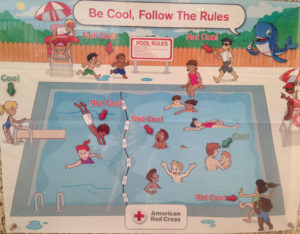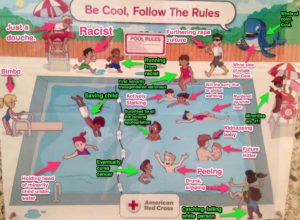Boy, this Red Cross poster is really wacko. Everybody knows black students don’t misbehave as much as white and asian kids.
Washington Post: When Margaret Sawyer first noticed the Red Cross safety poster at a pool in Salida, Colo., she thought she was looking at an unfortunate relic of the past.
When she saw it a second time at an entirely different pool in the central Colorado town, she was shocked, according to NBC affiliate KUSA.
“I saw this one, and I just kept thinking, ‘It looks like they’re trying to do something here that shows all kids together of all different backgrounds, but they’re clearly not hitting the mark,’” she said.
Not only were the poster’s designers not hitting the mark, Sawyer thought, they had created an image that was racist. Sawyer complained to a lifeguard at the first facility and penned a letter to management asking for the poster’s removal, she told KUSA.
After seeing the poster a second time, she posted an image of it online.
“I felt really angry,” she said.
The poster — titled “Be Cool, Follow The Rules” — depicts various children playing at the pool. But white children are labeled as behaving in a “cool” way while children of color who are depicted defying pool rules are labeled “not cool.”
KUSA discovered that the poster was from a safe-swimming campaign in 2014.
The Red Cross apologized for the “Be Cool” posters in a statement that was posted online Monday:
The American Red Cross appreciates and is sensitive to the concerns raised regarding one of the water safety posters we produced. We deeply apologize for any misunderstanding, as it was absolutely not our intent to offend anyone. As one of the nation’s oldest and largest humanitarian organizations, we are committed to diversity and inclusion in all that we do, every day.
To this end, we have removed the poster from our website and Swim App and have discontinued production. We have notified all of our partner aquatic facilities requesting they take down the poster. Our organization has emphasized to our partners and on social media that it was absolutely not our intent to offend anyone and apologized for this inadvertent action. We are currently in the process of completing a formal agreement with a diversity advocacy organization for their guidance moving forward.
But others wondered how a racially insensitive poster could have been published by the Red Cross in the first place…
JUNE 9, 2015: Texas pool party chaos: ‘Out of control’ police officer resigns
(CNN)Just days after a video that went viral online showed him yanking a 14-year-old bikini-clad girl to the ground and kneeling on her back, Eric Casebolt has resigned from his post as a corporal for the Police Department in McKinney, Texas. (Wikipedia)
The video posted to YouTube showing the police response to reports of fighting at a pool party sparked swift allegations of racism. Critics decried the white officer for cursing at several black teenagers, slamming the girl to the ground and unholstering his gun.
Protesters marched Monday over the incident in the Dallas suburb. Outraged parents demanded the officer’s firing.
At a press conference Tuesday announcing Casebolt’s resignation, the city’s police chief called his actions in the video indefensible.
“Our policies, our training, our practice, do not support his actions,” Police Chief Greg Conley said. “He came into the call out of control, and as the video shows, was out of control during the incident.”
Officials previously had said Casebolt was on administrative leave as police investigated what happened. Now that he has decided to resign, the internal affairs investigation is closed, and it’s too soon to say whether he’ll face charges over what happened, Conley told reporters.
“We’re continuing an investigation. We are continuing looking into all the allegations that are being presented to us, and any part of a criminal investigation regarding anyone will take a matter of time for us to work through all those allegations and those people who have come forward to us to complain,” he said.
Casebolt’s attorney has not responded to requests for comment.
Even as protests mount, some witnesses have praised the way Casebolt handled the incident, as dramatically different accounts emerge of whether race played a role in the situation and its aftermath.
Tatyana Rhodes, who was hosting a party at the pool Friday before police arrived, said tensions were running high after a racially charged fight broke out there. It started, she said, when two white women told a group of African-American teens they should leave and “go back to their Section 8 homes.”
One of the women, she said, smacked her in the face.
But Rhodes said the police officer took things too far.
“He didn’t have to use aggression,” she told CNN’s “Erin Burnett: Outfront.”
Now, she says she’s glad he has stepped down.
“I’m happy that he’s resigning,” she said. “I feel that everyone in McKinney will feel better that he’s resigning. … It’s the first step.”
Brandon Brooks, the 15-year-old white teen who shot the video, said there’s no doubt race was a factor in how police responded. He said the officer was targeting black teens at the scene.
“I was one of the only white people in the area when that was happening,” he told CNN affiliate KDAF. “You can see in part of the video where he tells us to sit down, and he kinda like skips over me and tells all my African-American friends to go sit down.”
USA TODAY: In pools, young blacks drown at far higher rates
NEW YORK (AP) — Swimming pools are a much greater danger to black children and teens than they are to other kids, a new government study shows.
Black children ages 5 to 19 drown in swimming pools at a rate more than five times that of white children, the research found. That suggests a lot of blacks are not learning to swim, said the lead author, Dr. Julie Gilchrist of the Centers for Disease Control and Prevention.
Swimming is a life-saving skill, not just another sport, she said.
The racial differences were smaller for drownings in lakes or other bodies of water. Experts think that’s because relatively few blacks go boating or participate in other water activities
Drowning is a major cause of death in children and young adults, and researchers have long observed a higher rate in African-Americans. The report released Thursday looked at racial differences in far greater detail, by age and by where youths drown.
Among whites, drowning rates peak in toddlers but then decline dramatically around age 5 and stay down. Experts think that’s a result of swimming lessons kicking in.
Among blacks, the drowning rate for toddlers is lower, but it doesn’t drop off the same way as children get older.
An earlier study showed that nearly 60 percent of black children surveyed were unable to swim or felt uncomfortable in the deep end of a pool, compared to 31 percent of white kids.
Because of the victims’ race, the gruesome incident has swelled interest in an obscure yet startling statistic: Some 70 percent of African-American youth can’t swim, and drowning rates for young blacks are far higher than for whites. Every summer, the grim news reports roll out like clockwork. Two weeks ago, a 12-year-old boy drowned in a neighbor’s pool in Maryland; his uncle then drowned trying to save him. The week before that, a pair of teenage boys were found at the bottom of a swimming pool in Iowa. And a month prior to that, an 11-year-old boy drowned in a swimming pool on Long Island. In every case, the young victim was African American and did not know how to swim.
“What happened in Louisiana is a tragedy,” says freestyle sprint swimmer and Olympic gold medalist Cullen Jones, only the third African American ever to make the U.S. Olympic Swim Team. “My heart feels very heavy when I hear of these things.”
For many people, swimming is one of those rudimentary skills that they can’t even remember learning, like walking or riding a bike. This used to be the case for most black people, too, until slavery entered the picture.
“If a slave could swim, he could escape, so a fear of water was put into people, and that fear has been passed down throughout the generations,” says Agnes Davis, president and CEO of Swim, Swim, Swim, I Say, the local partner of the Make a Splash swimming program in Harlem. Davis says she started her academy in 2009 after she got laid off from a high-paying job in the medical field. “What made me decide to do this,” she explains, “was that last summer in New York City, we had seven people drown—four of them adults, three of them children, all of them of minority descent.”
During the 20th century, racial segregation again conspired to drive blacks further from the water. Public swimming facilities that were built across the country in the early and mid-1900s were often for whites only. As Jeff Wiltse, author of Contested Waters: A Social History of Swimming Pools in America, told NPR, even in cities that did not have an official policy of segregation, “Whites set up, essentially, sentinel guards at the entrance to the pool, and when black swimmers tried to come in and access them, they were beaten up, sometimes with clubs.”
Perhaps because of these factors, even today, blacks appear to be more prone to hydrophobia than whites. Dr. Carol C. Irwin, assistant professor of health and sport sciences at the University of Memphis, is one of the authors of the latest study on swimming abilities among minorities, which surveyed more than 2,000 minority children and parents in Atlanta, Boston, Denver, Memphis, San Diego, and Minneapolis-St. Paul. “The parents and the kids fear drowning and injury when they are near the water,” she says. “We found this over and over again.”


